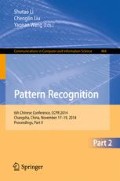Abstract
The sparse representation based classifier (SRC) has been successfully applied to robust face recognition (FR) with various disguises. Following SRC, recently regularized robust coding (RRC) was proposed for more robustness to facial occlusion by designing a new robust representation residual term. Although RRC has achieved the leading performance, it ignores the prior knowledge embedded in facial disguises. In this paper, we proposed a novel facial disguise learning (FDL) model, in which the unknown occlusion pattern in the query image is learned using a collected disguise mask dictionary. Two learning strategies with an iterative reweighted coding algorithm, independent FDL and joint FDL, were presented in this paper. The experiments on face recognition with disguise clearly show the advantage of the proposed FDL in accuracy and efficiency.
Access this chapter
Tax calculation will be finalised at checkout
Purchases are for personal use only
Preview
Unable to display preview. Download preview PDF.
References
Wright, J., Yang, A.Y., Ganesh, A., Sastry, S.S., Ma, Y.: Robust face recognition via sparse representation. IEEE Trans. Pattern Analysis and Machine Intelligence 31(2), 210–227 (2009)
Zhang, L., Yang, M., Feng, X.C.: Sparse representation or collaborative representation: which helps face recognition? In: Proc. ICCV (2011)
Fidler, S., Skocaj, D., Leonardis, A.: Combining Reconstructive and Discriminative Subspace Methods for Robust Classification and Regression by Subsampling. IEEE Trans. Pattern Analysis and Machine Intelligence 28(3), 337–350 (2006)
Yang, M., Zhang, L., Yang, J., Zhang, D.: Regularized robust coding for face recognition. IEEE Trans. Image Processing 22(5), 1753–1766 (2013)
Zhao, W., Chellppa, R., Phillips, P.J., Rosenfeld, A.: Face recognition: A literature survey. ACM Computing Survey 35(4), 399–458 (2003)
Belhumeur, P.N., Hespanha, J.P., Kriengman, D.J.: Eigenfaces vs. Fisherfaces: recognition using class specific linear projection. IEEE Trans. Pattern Analysis and Machine Intelligence 19(7), 711–720 (1997)
Ahonen, T., Hadid, A., Pietikainen, M.: Face description with local binary patterns: Application to face recognition. IEEE Trans. Pattern Analysis and Machine Intelligence 28(12), 2037–2041 (2006)
Leonardis, A., Bischof, H.: Robust recognition using eigenimages. Computer Vision and Image Understanding 78(1), 99–118 (2000)
Chen, S., Shan, T., Lovell, B.C.: Robust face recognition in rotated eigenspaces. In: Proc. Int’l Conf. Image and Vision Computing, New Zealand (2007)
Martinez, A.M.: Recognizing Imprecisely localized, partially occluded, and expression variant faces from a single sample per class. IEEE Trans. Pattern Analysis and Machine Intelligence 24(6), 748–763 (2002)
He, R., Zheng, W.S., Hu, B.G.: Maximum correntropy criterion for robust face recognition. IEEE Trans. Pattern Analysis and Machine Intelligence 33(8), 1561–1576 (2011)
Yang, M., Zhang, L.: Gabor Feature Based Sparse Representation for Face Recognition with Gabor Occlusion Dictionary. In: Daniilidis, K., Maragos, P., Paragios, N. (eds.) ECCV 2010, Part VI. LNCS, vol. 6316, pp. 448–461. Springer, Heidelberg (2010)
Martinez, A., Benavente, R.: The AR face database. CVC Tech. Report No. 24 (1998)
Gao, W., Cao, B., Shan, S.G., Chen, X.L., Zhou, D.L., Zhang, X.H., Zhao, D.B.: The CAS-PEAL Large-Scale Chinese Face Database and Baseline Evaluations. IEEE Trans. on System Man, and Cybernetics (Part A) 38(1), 149–161 (2008)
Yang, A.Y., Ganesh, A., Zhou, Z.H., Sastry, S.S., Ma, Y.: A review of fast l1-minimization algorithms for robust face recognition. arXiv:1007.3753v2 (2010)
Jia, H., Martinez, A.: Support vector machines in face recognition with occlusions. In: Proc. CVPR (2009)
Author information
Authors and Affiliations
Editor information
Editors and Affiliations
Rights and permissions
Copyright information
© 2014 Springer-Verlag Berlin Heidelberg
About this paper
Cite this paper
Yang, M., Shen, L. (2014). Robust Face Recognition via Facial Disguise Learning. In: Li, S., Liu, C., Wang, Y. (eds) Pattern Recognition. CCPR 2014. Communications in Computer and Information Science, vol 484. Springer, Berlin, Heidelberg. https://doi.org/10.1007/978-3-662-45643-9_33
Download citation
DOI: https://doi.org/10.1007/978-3-662-45643-9_33
Publisher Name: Springer, Berlin, Heidelberg
Print ISBN: 978-3-662-45642-2
Online ISBN: 978-3-662-45643-9
eBook Packages: Computer ScienceComputer Science (R0)

